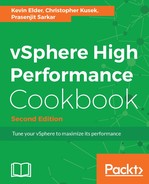Deciding whether or not to configure FT depends on the workloads of the protected VMs. One of the major reasons to choose FT is if you require zero or near zero downtime for a critical workload. If you perform a current state analysis of an existing infrastructure and find some critical workloads already protected in the physical infrastructure, it is most likely that these workloads require protection in a VMware virtual infrastructure as well. FT is simple to configure and can offer a wide range of workloads to be protected. However, it works for uniprocessor VMs, which is a deal killer for most VMs that would otherwise get FT.
However, there are a number of limitations associated with the configuration of FT. Many fundamental virtualization benefits are lost, including the use of VM snapshots and VMware vSphere Storage vMotion.
There are a number of prerequisites and configurations on the infrastructure side, which should be in place before you configure FT. They are as follows:
- FT can only be configured in a vSphere HA cluster. You should have at least three hosts in the cluster because if one host fails, there will be two hosts servicing two FT VMs (one vCPU limitation per VM).
- To avoid performance problems, every host that you have in the HA cluster should have a similar CPU configuration. Say you have slower CPUs on some hosts and faster CPUs on some other hosts. In this case, when the secondary VM runs on the slower CPU host, the primary machine has to stop continuously to allow the secondary server to catch up.
- ESXi hosts must have access to the same datastore and networks.
There is a varied number of infrastructure impacts on the FT. One of them, which is crucial, is contention on the FT logging network. VMware requires at least one physical 1 GB Ethernet network for the logging network. You should have another 1 GB Ethernet for vMotion. Also, vMotion and FT should be on a separate subnet.
VMware also recommends that you configure no more than four FT-protected VMs per host, with 1 GB logging network. The number of VMs that are protected by FT that you can safely run on each host is based on the sizes and workloads of the ESXi host and the VMs.
To reduce the contention over the FT network, you should configure a 10 Gbps logging network, which increases the available bandwidth. Also, you should distribute the primary hosts across multiple physical hosts because logging traffic is asymmetric. Distributing primaries across different hosts allow the logging network to benefit from the Ethernet's bidirectional capability.
